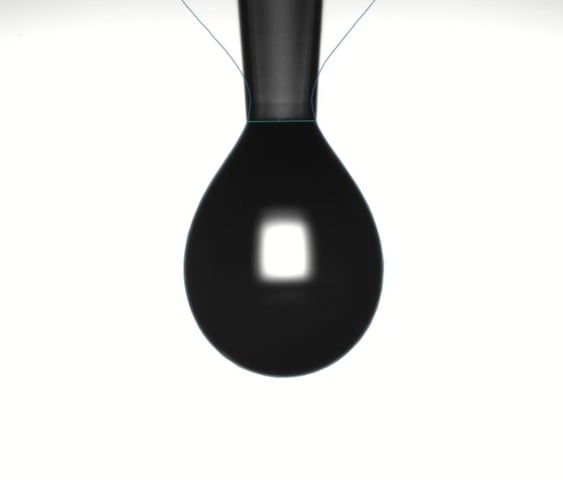
The surface tension of a liquid is easily measured with methods like pendant drop and Du Noüy ring. This measurement gives a surface tension value that can be compared to the other formulations or surface free energy of the surface. However, a single surface tension measurement is not able to tell anything about the nature of interactions between the molecules in the liquid. To gain more information, it is possible to determine the polar and dispersive parts of the surface tension. The method to calculate the component is defined in ISO 19403-5:2017 standard. Below the procedure, as it is done in OneAttension software is explained.
The first step is to measure the surface tension of the liquid with the pendant drop method. In a pendant drop measurement, a large drop size is used to achieve the elongated, pendant shape of a drop. The desired drop size is set in the measurement recipe together with the recording settings. Remember also to set the correct density of the liquid as that is used in calculations. Once the start button is pressed, the measurement is done automatically. After the measurement is completed, the results can be analyzed. The software will automatically define the surface tension value for the liquid.
The contact angle of the liquid against a known solid should be measured next. A completely dispersive solid with the known surface free energy should be chosen. Most typically some kind of Teflon surface is used. The surface must be clean before making the measurement. The information on the surface free energy of the solid is filled in the recipe. To measure the contact angle, a drop of liquid is placed on the sample surface. The volume of the drop is typically between 3 to 5 microliters. When the drop size and recording settings are set, the play button is pressed and the measurement is automatically done by the instrument. After measurement, the results can be analyzed and the contact angle value is automatically presented.
To calculate the surface free energy components, select both measurement files, right-click, and calculate STC. This will make a virtual measurement with both measurement files included and automatically calculate the surface tension components for the liquid with both OWRK and Wu methods.
A wetting agent is a surface-active molecule used to reduce the surface tension of water.
The term surfactant comes from the word surface active agent. At the interface, they align themselves so that the hydrophobic part is in the air and the hydrophilic part is in water. This will cause a decrease in surface or interfacial tensions.
Surface tension plays an important role in Li-ion battery slurry optimization.
Surface tension plays an important role in the electroplating solution.
When measuring contact angles or making surface tension measurements with a pendant drop, selecting the correct tip or needle for your liquid is crucial.
The surface tension of water is about 72 mN/m at room temperature which is one of the highest surface tension for liquid.
Surface tension is a quantitative measure that can be correlated with a solution’s ability to remove dirt.
Surface tension and wettability are important physical properties that play a significant role in the effectiveness of agrochemicals.
Explains three different methods to measure surface tension.
